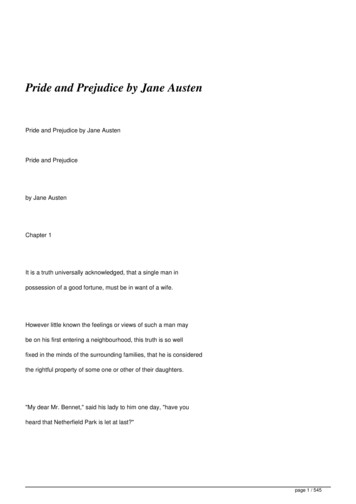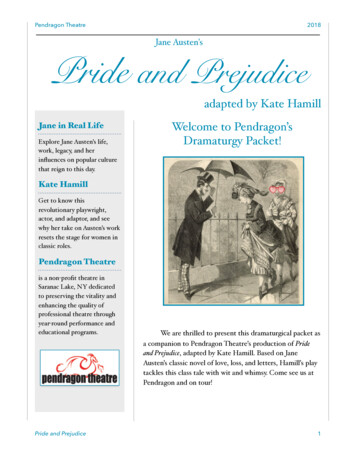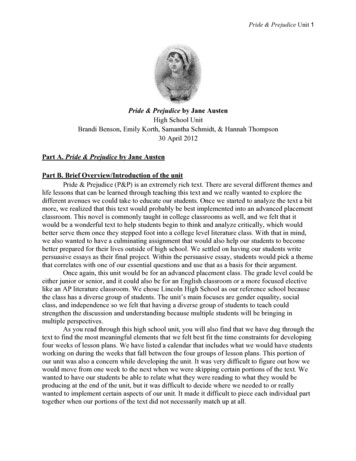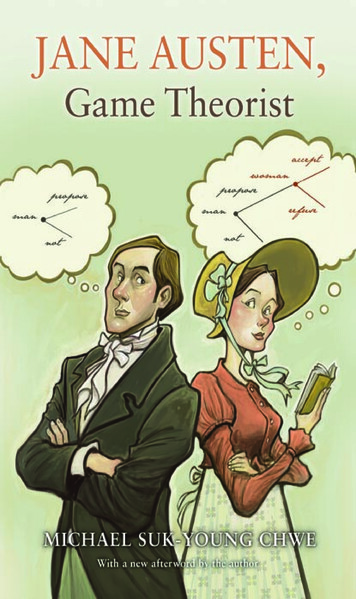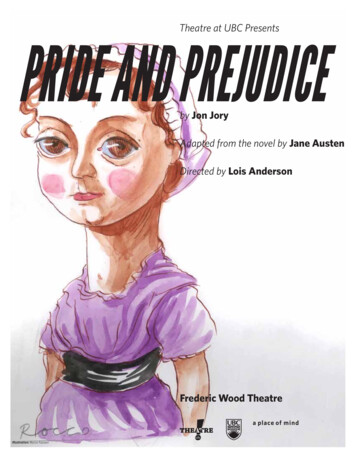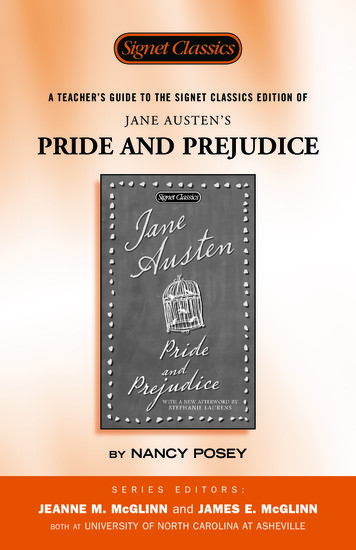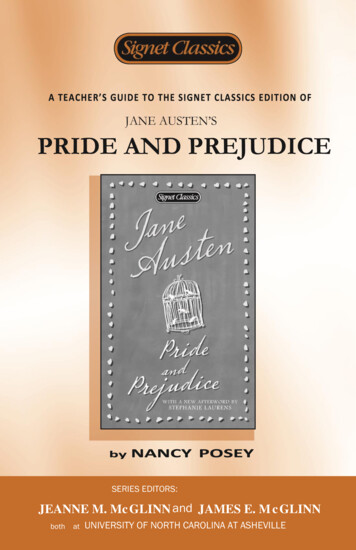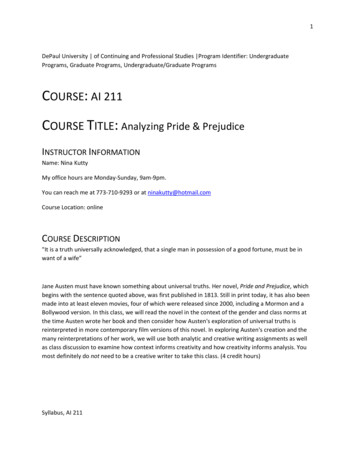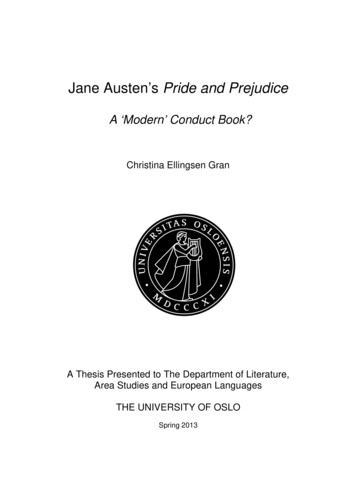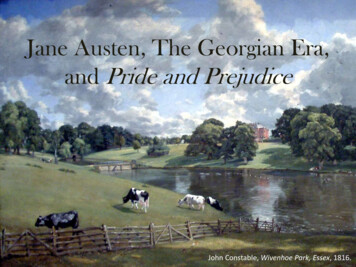
Transcription
Jane Austen, The Georgian Era,and Pride and PrejudiceJohn Constable, Wivenhoe Park, Essex, 1816.
British and World Events 1798-1832– 1801: Act of Union creates UnitedKingdom of Great Britain and Ireland– 1801: Union Jack becomes officialflag– 1803: United States: LouisianaTerritory purchased from France– 1804: Germany: Beethovencomposes Symphony No. 3– 1804: France: Napoleon crownshimself emperor– 1805: Battle of Trafalgar– 1813: Jane Austen publishes Prideand Prejudice– 1831: United States: Edgar Allan Poepublishes Poemshttp://www.youtube.com/watch?v kwRVR-TmKYwThe Coronation of Napoleon is a paintingcompleted in 1807 by Jacques-Louis David
Regency Period Research1. What is the Regency Period? Who was in power in England?2. How was Austen’s world affected by such international developments asthe Napoleonic War, the American Revolution, and the FrenchRevolution?3. What elements of popular culture mark this period? Research styles ofdress, art, music, dance, and games.4. What was the view of women during this time?5. Who was Mary Wollstonecraft?– Suggested Resources: d/
Explore the following: Classical Music—for example, Beethoven, Rossini, Schubert,Liszt and Mendelssohn Dance—Shift in popularity from country dances to the waltzwhich was considered controversial during Austen’s day Art—David, Turner, Constable History—Napoleonic Wars, French Revolution, AmericanRevolution (Note that Austen makes no reference to militaryactions in this novel, although this was a period of greatchange through war.) Science—Industrial Revolution, steam locomotion Religion—the Evangelical movement, mysticism and othertrends in religion during the late 18th and early 19th century Other areas—architecture, fashion, food, sports
The Georgian Era lasted from 1714 to 1830. It isnamed after the first four British kings from theHouse of Hanover, George I, George II, George III,and George IV.Jane Austen (1775-1817) lived entirely in the reign ofGeorge III (r. 1760-1820). Around 1811, George IIIwent insane, and his son (later George IV) ruled inhis place until the death of his father, a periodknown as the Regency.John Constable, View of Epsom
DynastyMonarchYearsHenry VII1485-1509Henry VIII1509-1547Edward VI1547-1553Mary I1553-1558Elizabeth I1558-1603StuartJames I1567-1625Charles I1625-1649NoneInterregnum1649-1660Charles II1660-1685James II1685-1688William III & Mary II1689-1702Anne1702-1714George I1714-1727George II1727-1760George III1760-1820George IV1820-1830William IV1830-1837Victoria1837-1901TudorStuartHanover
George III (r. 1760-1820) American War of Independence (1775-1783)French Revolution (1789-1799)Napoleonic Wars (1803-1815)Industrial Revolution (1750-1850)– Move from agricultural to urban society– Growth of factories and technologyJohn Constable, The Chain Pier, Brighton 1824-1827
Neoclassicism:(mid-eighteenth century themiddle of the nineteenthcentury) classical style; order;Enlightenment/Age of ReasonJacques-Louis David, Oath of the Horatii, 1784Romanticism:(earlynineteenth century)emotions painted in a bold,dramatic manner; return tonature; against science andreasonCaspar David Friedrich, WandererAbove the Sea of Fog, 1818
British Painting of the Late Georgian EraJohn Constable and J. M. W. Turner are two ofthe most important English painters of the lateGeorgian era. They were both importantlandscape painters, which was less appreciatedthan history paintings. However, Turner alsopainted history paintings, such as his Battle ofTrafalgar.
J. M. W. Turner, The Battle of Trafalgar (1822)
John Constable, The Hay Wain (1821)
Jane Austen(1775-1817) Born in Steventon,England George Austen (father)was the clergyman of thelocal parish. She was educated mostlyat home by her father withher seven siblings. Her writing began in herteens with parodies andskits to entertain herfamily.A water color and pencil sketch of Austen,believed to have been drawn from life by hersister Cassandra (c. 1810).
Austen’s Writings Sense and Sensibility (1811)Pride and Prejudice (1813)Mansfield Park (1814)Emma (1816)Northanger Abbey and Persuasionwere both published posthumouslyin 1818. She began a another novel, whichwas eventually titled Sanditon, butdied before completing it.
Anonymous WriterAusten published her novels anonymously, and onlyher family knew that she was the author of thesenovels.– Prevented her from acquiring and authorial reputation,but it enabled her to preserve her privacy. English society associated a female’s entrance into the publicsphere with a reprehensible loss of femininity.– Napoleonic Wars (1800-1815) threatened the safety ofmonarchies throughout Europe, so the governmentcensored literature.J.M.W. Turner, Off Margate, 1840
Writing Style “Novels of Manners” critique social customs,conventions, and behaviors of a particular social classat a specific time and place. Includes satirical wit (especially in the realities of loveand marriage)– Satirizes snobs and the poor breeding of the lower socialclasses. Often critical of the assumptions and prejudices ofupper-class England. Realistic about the lack of social mobility and theawareness of class.– Advancement for men: military, church, or law– Advancement for women: successful marriageJ.M.W. Turner, Seascape with Storm Coming On, ca. 1840
Pride & Prejudice History: originally titled First Impressions (1796-1797)– Rejected by publishers– In 1809, Austen began revisions– Pride and Prejudice published in January 1813 Genre: Comedy of manners (not a tragic ending) Setting: During Napoleonic Wars (1797-1815) in Longbourn,in rural England––––Netherfield Park, Bingley’s residencePemberly House, Darcy’s EstateThe Derbyshire countrysideRosings, the home of Lady Catherine Themes: Love, Reputation, ClassJ.M.W. Turner, Off Margate, 1840
John Constable, Salisbury Cathedral from the Bishop's Grounds, 1823.CharactersNarrator: Third-person omniscientPoint of View: Elizabeth Bennet (primarily)Protagonist: Elizabeth BennetAntagonist: Snobbish class-consciousness (epitomized by LadyCatherine de Bourgh and Miss Bingley)
Characters: Bennet Family Elizabeth Bennet—protagonist, the second of fivedaughters; pragmatic and independent; her father’sfavorite Miss Jane Bennet—Elizabeth’s older sister; wants tosee the best in everyone; Mary Bennett—the plain, bookish middle sister Miss Catherine (Kitty) Bennett—easily led and shallowfourth daughter Lydia Bennet—the youngest sister, flirty andundisciplined Mr. Bennet—their father, cynical and permissive Mrs. Bennet—their mother, whose main goal is to findhusbands for her daughtersFonthill Abbey in Wiltshire, England from the south west by J.M.W. Turner, 1799.
Characters: Bennet Friends Charlotte Lucas—Elizabeth’s best friend Sir William and Mrs. Lucas—The Bennets’neighbors Mr. Collins—the Bennet girls’ overbearing cousin, apriggish clergyman who stands to inheritLongbourn, the Bennets’ entailed estate The Gardiners—Mrs. Bennet’s brother and sisterin-law who live in London George Wickham—an attractive militia officerstationed near the BennetsFonthill Abbey in Wiltshire, England from the south west by J.M.W. Turner, 1799.
Characters: Bingley Family & Friends Mr. Charles Bingley—unmarried, wealthy young manwho has leased nearby Netherfield Miss Caroline Bingley—Mr. Bingley’s sister Mrs. Hurst—Bingley’s married sister Mr. Hurst—Bingley’s brother-in-law Mr. Fitzwilliam Darcy—Bingley’s prideful, wealthyfriend Miss Darcy—Darcy’s sister Col. Fitzwilliam—a relation of Darcy whose status assecond son leaves him with little wealth Lady Catherine de Bourgh—a condescending wealthysnob; patron of Collins; aunt of DarcyFonthill Abbey in Wiltshire, England from the south west by J.M.W. Turner, 1799.
Character Cards1. Elizabeth Bennet2. Miss Jane Bennet3. Miss Catherine(Kitty) Bennet4. Lydia Bennet5. Mr. Bennet6. Mrs. Bennet7. Charlotte Lucas8. Mr. Collins9. George Wickham10.Mr. Charles Bingley11.Mr. FitzwilliamDarcy12.Lady Catherine deBourghFonthill Abbey in Wiltshire, England from the south west by J.M.W. Turner, 1799.
Character Name(First, Last, ’ ThoughtsQualitiesCharacterCardsAs you read, focus onthe actions and wordsof the character. Writetheir name on the frontwith a visual example,and on the back addactions, words,qualities, relationships(especially to ElizabethBennet).
Vocab CardsBackDefinition:Synonym/Antonym:Original Sentence:Visual Example:FrontVocabulary WordPart of Speech
Vocab Cards ExampleBackDefinition: puzzled; confusedSynonym/Antonym: bewildered,enlightenedOriginal Sentence: He lookedperplexed by the questions on thetest.Visual Example:FrontPerplexedAdj. (adjective)
Pride & Prejudice Research:11. Pride and Prejudice Economics: Or Whya Single Man with a Fortune of 4,000 PerYear is a Desirable sirable-husband/2. A Pride and Prejudice Gazetteer : AGuide to the Real and Imagined Places ps/pp/Cary-231812-Eng-map.html3. JASNA: Where’s Where in Jane l4. The History of the tory/default.htm4
Pre-Reading Questions:1.2.3.4.5.6.7.8.9.First impressions are often wrong.Children are rarely justified in being embarrassed by their parents.Parents should have some say about whom their children marry.Families should be concerned with what others think.Love at first sight is a common occurrence.People communicate more effectively in the twenty-first century than they didduring the nineteenth century.“Happiness in marriage is entirely a matter of chance” (Charlotte, 21).Playing “hard to get” is useful in attracting members of the opposite sex.People are happiest when they marry within their own social class.John Constable, View of Epsom
Pride & Prejudice Research: 1. Pride and Prejudice Economics: Or Why a Single Man with a Fortune of 4,000 Per Year is a Desirable Husband 2. A Pride and Prejudice Gazetteer : A Guide to the Real and Imagined Places in the Novel 3. JASNA: Where's Where in Jane Austen's Novels 4. The History of the Novel 1 3 4 2

